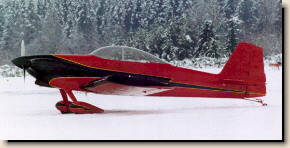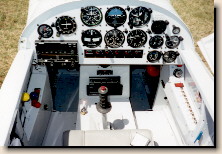|
Soon after the single-seat
RV-3 was introduced, it became obvious that a lot
of people wanted to share their RV Grin with a friend.
Van realized that he wasn�t going to be able to talk
them into building two RV-3s. He set out to design
a two-place airplane that performed and handled as
much like the RV-3 as possible. This was not as easy
as just "stretching the RV-3."
The RV-4 was an entirely
new design. A poll of prospective customers, taken
in the early 1970s, showed a strong preference for
tandem seating. This suited Van as well, putting the
pilot on the centerline and keeping frontal area to
a minimum. He knew that a bigger, heavier airplane
could never perform and handle quite as well as a small, light one, but when the RV-4 first flew in
August, 1979, the results were better than he�d dared
dream. The top speed was only 10 mph less than the
speedy RV-3, and the handling qualities, so difficult
to define, were virtually identical.
a small, light one, but when the RV-4 first flew in
August, 1979, the results were better than he�d dared
dream. The top speed was only 10 mph less than the
speedy RV-3, and the handling qualities, so difficult
to define, were virtually identical.
The RV-4 holds two people and their baggage. The
seating is compact, but still comfortable. It is flown
from the front seat only, but the kit includes a stick
for the rear seater so he or she can share the fun. It
is designed for engines of 150-160 horsepower, although
engines as small as 125 hp and as large as 180 are
approved and commonly installed.
The all-around capabilities of the RV-4 are
impressive. It is capable of excellent "sport"
aerobatics, and several RV-4 pilots have successfully
competed in organized aerobatic competitions, scoring
well against specialty aerobatic airplanes.
Others have used their RV-4s for sport of a different
kind, flying regularly into backcountry strips for the
fishing and recreation. More than one SuperCub pilot has
been startled to land at a out of the way mountain strip
and find an RV-4 already there.
 The
RV-4 is also an excellent cross-country machine. Many
couples routinely use the airplane as a long distance
"time machine." The ability to land at any
small airport means they can get where they really
want to go, not just to the nearest big-city airport.
The RV-4 takes them to fly-ins, to reunions, to vacations,
and to visit the kids and grandkids. Distance is not
a problem. An RV-4 is capable of crossing half of
North America in a day. The
RV-4 is also an excellent cross-country machine. Many
couples routinely use the airplane as a long distance
"time machine." The ability to land at any
small airport means they can get where they really
want to go, not just to the nearest big-city airport.
The RV-4 takes them to fly-ins, to reunions, to vacations,
and to visit the kids and grandkids. Distance is not
a problem. An RV-4 is capable of crossing half of
North America in a day.
For some, NO distance is a problem� Australian Jon
Johanson has flown his RV-4 around the world,
oceans, deserts, mountains and all. And he�s done it
twice.
Van�s has been supplying and improving kits for
RV-4 for almost twenty years and it has become one of
the most popular kit aircraft in the world. Somewhere
between 900 and 1000 examples have been flown in
countries all over the globe.
|